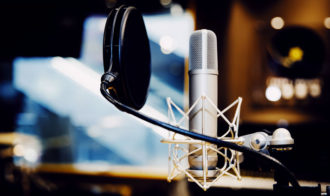 “I studied biology, but my background was creative, arts-based,” he says. “I’ve always been interested in words and working with them feels natural to me.”
So how does the note taking process work? Shogo explains:
“Before the meeting, the customer usually provides me with a list of participants and a glossary of any tricky terms. That helps me set up a template in advance and do some research into the specific background and context of the meeting.”
In most cases, Shogo attends in person, although occasionally he will take the notes for a conference call where participants are at different locations. Meetings typically last between 30 minutes and four hours, while more complex hearings can last for several days.
Clients often choose the note taking service when they are not able or permitted to make an audio or video recording for transcription later, for example at grievance or disciplinary hearings, employment tribunals, staff and trades union consultations or other proceedings overseen by Human Resources teams.
Once the meeting is concluded, the note taker faces the daunting task of turning their notes into a transcript.
“The notes are often a bit untidy at first,” admits Shogo. “Questioning can be rapid fire and the atmosphere tense; people’s jobs are sometimes on the line. I estimate that for every hour I spend at a meeting I spend another two ‘cleaning up’ afterwards to create an accurate, readable transcript.”
Whilst the usual turnaround time for note taking is a few days, Shogo is sometimes tasked with returning a transcript within 48 hours. The final product is a near-verbatim written record, logged so that customers can easily search for and find specific section or speakers.
“I studied biology, but my background was creative, arts-based,” he says. “I’ve always been interested in words and working with them feels natural to me.”
So how does the note taking process work? Shogo explains:
“Before the meeting, the customer usually provides me with a list of participants and a glossary of any tricky terms. That helps me set up a template in advance and do some research into the specific background and context of the meeting.”
In most cases, Shogo attends in person, although occasionally he will take the notes for a conference call where participants are at different locations. Meetings typically last between 30 minutes and four hours, while more complex hearings can last for several days.
Clients often choose the note taking service when they are not able or permitted to make an audio or video recording for transcription later, for example at grievance or disciplinary hearings, employment tribunals, staff and trades union consultations or other proceedings overseen by Human Resources teams.
Once the meeting is concluded, the note taker faces the daunting task of turning their notes into a transcript.
“The notes are often a bit untidy at first,” admits Shogo. “Questioning can be rapid fire and the atmosphere tense; people’s jobs are sometimes on the line. I estimate that for every hour I spend at a meeting I spend another two ‘cleaning up’ afterwards to create an accurate, readable transcript.”
Whilst the usual turnaround time for note taking is a few days, Shogo is sometimes tasked with returning a transcript within 48 hours. The final product is a near-verbatim written record, logged so that customers can easily search for and find specific section or speakers.
 Says Shogo: “The final notes are not minutes or summaries. The transcript is as close to verbatim as possible; an amalgamation of the background information I’ve been given, the notes I type in the room and any extra handwritten notes I have made during the meeting.”
Although many customers choose the note taking service because they can’t make an audio or video recording, some simply prefer it to the other options available. From time to time, Shogo even takes notes at meetings that are also being recorded.
“Sometimes clients are wary of the recording technology,” he says. “For them, note taking offers a simpler, more straightforward solution but with no compromise on accuracy. Other customers just like having a note taker in the room, even if proceedings are being recorded.”
Technological developments are transforming the process of turning speech into text. But it seems that despite this, sometimes, only a human will do.
—
Find out more about Appen’s note taking services at: appen.com/uk/#services
Says Shogo: “The final notes are not minutes or summaries. The transcript is as close to verbatim as possible; an amalgamation of the background information I’ve been given, the notes I type in the room and any extra handwritten notes I have made during the meeting.”
Although many customers choose the note taking service because they can’t make an audio or video recording, some simply prefer it to the other options available. From time to time, Shogo even takes notes at meetings that are also being recorded.
“Sometimes clients are wary of the recording technology,” he says. “For them, note taking offers a simpler, more straightforward solution but with no compromise on accuracy. Other customers just like having a note taker in the room, even if proceedings are being recorded.”
Technological developments are transforming the process of turning speech into text. But it seems that despite this, sometimes, only a human will do.
—
Find out more about Appen’s note taking services at: appen.com/uk/#services 







